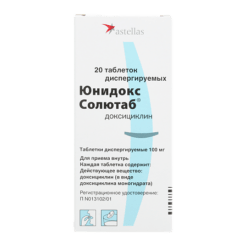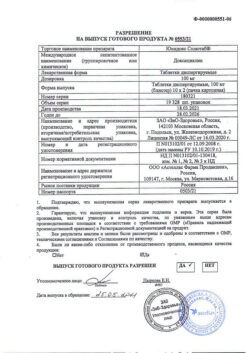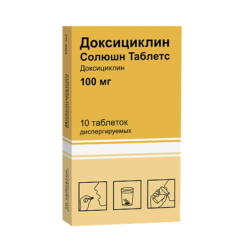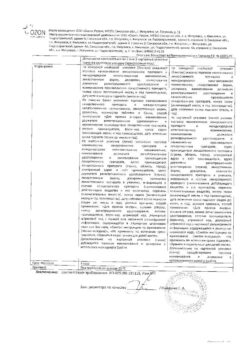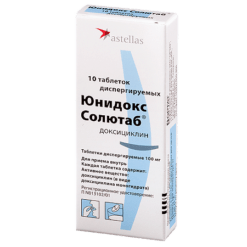No products in the cart.
Doxycycline, capsules 100 mg, 20 pcs.
€1.00
Out of stock
(E-mail when Stock is available)
Description
Pharmacotherapeutic group: Antibiotic, tetracycline
ATX code: J01AA02
Pharmacodynamics:
Semisynthetic tetracycline is a bacteriostatic broad spectrum antibiotic derived from metacycline. By penetrating into the cell it acts on intracellular pathogens. Ilinnonpyei synthesis of pro:sips and the microbial cell by disrupting the binding of transport aminoacyl-RPK with 30S subunits of the ribosomal membrane. It affects the synthesis of the bacterial cell wall.
It is highly sensitive to: Gram-positive microorganisms Staphylococcus spp. (including Slaphvlococcus aureus Staphylococcus albus). Streptococcus spp. (including Streptococcus pneumoniae). Clostridium spp. Listeria spp.; and Gram-negative microorganisms: Neisseria H.coli. Shigella spp.; Enterobacter; Salmonella spp; Pasterella spp. Bacteroides spp.; Psyttacosis spp.; Treponema spp. (including strains resistant to other antibiotics such as modern penicillins and cephalosporins). The most sensitive are Haemophilus influenzae (91-96%) and intracellular pathogens.
Pharmacokinetics:
Absorption is fast and high (about 100%). It has a high degree of lipid solubility and low affinity for calcium binding.
After oral administration of 200 mg, time to reach maximum concentration is 2.5 h. Maximum concentration is 2.5 mcg/ml. 24 h after administration is 1.25 mcg/ml. It is bound with plasma proteins – 80-90 %.
It penetrates into organs and tissues: 30-45 minutes after oral administration it is found in therapeutic concentrations in liver kidneys lungs spleen bones teeth prostate gland eye tissue in pleural and ascitic fluid: bile synovial exudate exudate of maxillary and frontal sinuses. Poor penetration into cerebrospinal fluid (10-20% of plasma level). It penetrates through placental barrier and is determined in mother’s milk.
Metabolized 30-60% in liver. Period of elimination half-life is 16-24 hours. The drug may cumulate when administered repeatedly. It is accumulated in bone tissue. It forms insoluble complexes with calcium in bones and teeth.
It is taken out with bile where it is found in high concentration. It is eliminated in intestinal hepatic recirculation with feces (20-60%); 40% of administered dose is excreted by kidneys during 72 hours (including 20-50% – unchanged) in patients with severe chronic renal insufficiency – only 1-5%. In patients with impaired renal function or azotemia gastrointestinal tract is an important route of excretion.
Indications
Indications
Active ingredient
Active ingredient
Composition
Composition
How to take, the dosage
How to take, the dosage
The medication is taken orally with a glass of water during or after meals. The capsules are taken while sitting or standing and well before bedtime to reduce the risk of irritation and ulceration of the esophagus. If there are signs of gastric irritation, it is recommended that doxycycline be taken with food or milk.
The usual dosage for treatment of acute infections for adults and children over 12 years of age with body weight over 45 kg is 200 mg (2 capsules) in 1 or 2 doses on the first day, from the second day – 100 mg (1 capsule) once a day. Maximum daily dose in severe infections is 200 mg/day in 1-2 doses (especially in chronic urinary tract infections).
The duration of treatment depends on the type of infection and is usually 5-10 days. In Lyme disease the course of treatment is 3-4 weeks, in brucellosis – 1.5-6 months. Therapy shall be continued for at least 24-48 hours after the disappearance of symptoms. In case of streptococcal infection the duration of therapy should be at least 10 days to prevent rheumatism or glomerulonephritis.
Uncomplicated gonococcal infection in adults (except for ano-rectal infection in men): 100 mg twice daily for 7 days. Alternatively, a starting dose of 300 mg, followed by a second dose of 300 mg an hour later.
Uncomplicated urethritis, endocervicitis or rectal infection in adults caused by C. trachomatis: 100 mg twice daily for 7 days.
Nongonococcal urethritis caused by C. trachomatis or U. urealyticum: 100 mg twice daily for 7 days.
Early syphilis: 100 mg 2 times daily for 2 weeks (for non-pregnant patients with penicillin allergy).
Syphilis lasting more than one year: 100 mg 2 times daily for 4 weeks (for non-pregnant patients with penicillin allergy).
Acute epididymo-orchitis caused by N. gonorrhoeae or C. trachomatis: 100 mg twice daily for at least 10 days.
In the treatment of acne – 50 mg/day for 6-12 weeks.
Treatment of malaria caused by chloroquine-resistant P. falciparum: 200 mg/day for at least 7 days. Given the potential severity of infection, a fast-acting schizonticidal drug, such as quinine, should be used concomitantly with doxycycline; recommended dosages vary by region.
Malaria prophylaxis: 100 mg/day in adults; in children over 12 years of age, the drug is prescribed at a dose of 2 mg/kg once daily; the dose may be as high as that for adults. Prophylaxis may be given 1-2 days before travel to a region where malaria occurs. It should be continued throughout the trip and for 4 weeks after return.
Prevention of Japanese river fever: 200 mg once orally.
Prevention of traveler’s diarrhea in adults: 200 mg on the first day of travel (once or 100 mg every 12 hours) and then 100 mg/day for the duration of stay in the region. There is no information about prophylactic use of the drug for more than 21 days.
Leptospirosis prophylaxis: 200 mg orally once a week for the duration of stay in the region and 200 mg at the end of the trip. There is no information about prophylactic use of the drug for more than 21 days.
Pulmonary anthrax (after exposure): adults 100 mg orally 2 times a day for 60 days. In children with body weight less than 45 kg 2.2 mg/kg orally 2 times a day for 60 days. In children with body weight over 45 kg doxycycline is used in the usual dosage for adults.
In case of tick-borne and louse-borne relapsing fever doxycycline was successfully used in a single dose of 100 mg or 200 mg, depending on the severity of infection. To reduce the risk of persistence or recurrence of tick-borne relapsing fever, doxycycline is recommended at 100 mg every 12 hours for seven days.
Elderly patients: no dose adjustment is necessary.
Hepatic disorders: doxycycline should be used with caution in patients with hepatic insufficiency or in patients receiving potentially hepatotoxic medicines.
With impaired renal function: Studies have shown that the use of doxycycline in the usual recommended doses does not lead to excessive accumulation of the antibiotic in patients with impaired renal function.
Dose adjustment is not required in the presence of renal impairment.
Interaction
Interaction
Special Instructions
Special Instructions
Contraindications
Contraindications
Side effects
Side effects
Similarities
Similarities
Additional information
| Shelf life | 3 years. Do not use after the expiration date. |
|---|---|
| Conditions of storage | In a dry place protected from light at a temperature not exceeding 25 ° C out of the reach of children. |
| Manufacturer | Borisov Medical Preparations Plant, Belarus |
| Medication form | capsules |
| Brand | Borisov Medical Preparations Plant |
Other forms…
Related products
Buy Doxycycline, capsules 100 mg, 20 pcs. with delivery to USA, UK, Europe and over 120 other countries.


